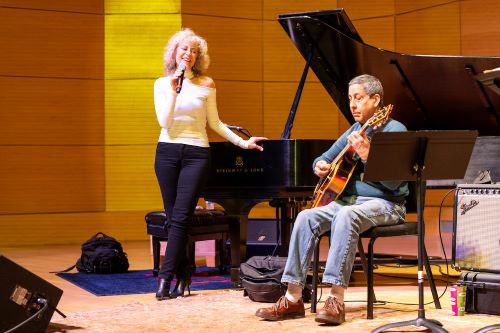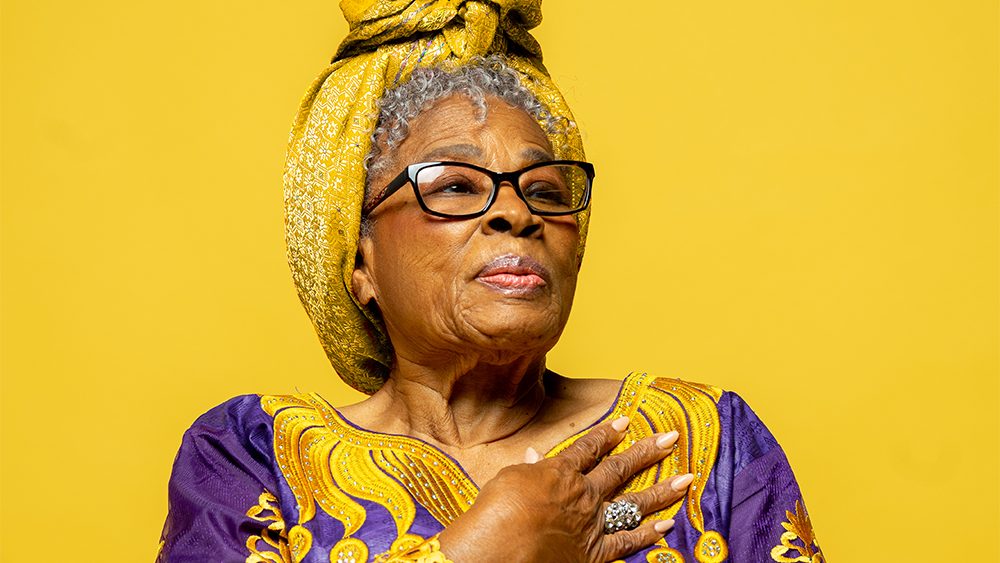
RADFORD – Pianist and vocalist Judy Carmichael performed March 3 at the Covington Center’s Davis Performing Hall, bringing with her a mixture of swing and ragtime jazz, standards, and originals.
A virtuoso of the stride piano style — in which the right hand creates the melody while the left provides bass notes and chords — Carmichael, along with guitarist James Chirillo and Dan Block on clarinet and tenor saxophone, delivered an 80-minute set, complete with classics such as “I Got Rhythm” and “Honeysuckle Rose.”
During her two-day stay in the New River Valley, the California native also found time to visit with Radford University students and share life lessons garnered across her time as a professional musician and as the host of the radio show and podcast, “Judy Carmichael’s Jazz Inspired.”
“She just feels it’s so important to reach out to the students,” said Ashlee Claud, general manager of Public Radio WVRU. “Every time she comes here, it really gets paid back in spades.”
Carmichael spoke to a music business class, and the following day, Chirillo and Block and she presented an hourlong masterclass session for faculty and students, a conversation sprinkled with music, including “All the Cats Join In,” during which she encouraged the audience to snap along in time with the tune.
During both discussions, Carmichael touched on three topics in particular: the stages that led her to become the musician she is today; the challenges that came with being a woman in the male-dominated genre of jazz; and the best practices for making a modern living within a creative field.
As a child struck by a love of old Fred Astaire films and classic musicals, Carmichael initially considered becoming “a tap-dancing, singing, acting person in a ’30s movie,” albeit decades too late.
Her grandfather pressed her to learn piano. Then an early brush with just the right Count Basie record sealed her jazz aspirations for good.
“That particular kind of music really inspired me, and I thought, ‘I want to learn how to do that,'” she told the students, and so she did. She cultivated an ability to play ragtime piano for hours on end, which ultimately landed her an extended gig at Disneyland Park where she became its first female instrumentalist.
That minority status would follow her into the realm of jazz clubs, where – tall, blonde and svelte – she stood out on bandstands almost uniformly occupied by men, and where, as a result, “I was never really anonymous,” she said.
More than a dozen albums followed with Carmichael eventually grabbing the reins to produce her own recordings and to release them through her own music label, C&D Productions, an ambitious move she said has paid distinct dividends.
“I said, ‘Forget it! I’ll be in charge!’” she said. “I had more control, and I made a lot more money that way.”
She also wrote several books including guides to playing stride piano and a 2017 memoir, “Swinger!: A Jazz Girl’s Adventures from Hollywood to Harlem.”
Carmichael cautioned students they would need focus, discipline, self-confidence and perseverance if they wanted to gain traction in a creative profession.
“For those of you that are thinking about music careers, a small part of it is actually getting to play,” she said during the master class. Gesturing to the stage around her, she said, “Ninety percent of the time, it’s not this. It’s practice. It’s the business. It’s setting up gigs.
“I think if you’re pursuing a music career, you will be discouraged a lot,” Carmichael said, but she also tempered those warnings with encouraging suggestions.
One was an oft-repeated but invaluable showbiz chestnut: “Show up on time. And don’t be a jerk.
Be kind,” she said. “I cannot emphasize that enough.”
Another tidbit was a recollection of a conversation she had with her idol, Count Basie, who told her that “the real secret” to life was to listen. Just listen.
“That’s the best advice I could give you all, she said. “If everybody listened, it’d be a better world.”
And one of her closing notes invoked the emotional and psychologically therapeutic qualities music and art in general often possess and the virtues of circulating creativity.
“We’re all choosing to do something that puts beauty into the world. And that’s important, to contribute something,” Carmichael said.
“That’s something to always come back to. You’re doing something important, and you’re putting something that’s healing and beautiful out in the world.”
Neil Harvey
Radford University

